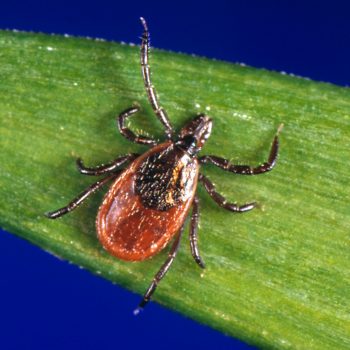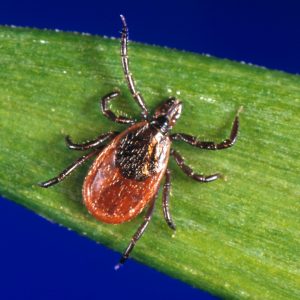

May is Lyme Disease Awareness Month

What is Lyme disease?
As I explain in Chapter 8 of my book, Your Longevity Blueprint, Lyme disease is a vector-born disease contracted from the bite of a small tick, transmitting the spiral-shaped bacteria (spirochete) Borrelia burgdorferi.
As the International Lyme and Associated Diseases Society (ILADS) states, “Ticks know no borders and respect no boundaries. A patient’s county of residence does not accurately reflect his or her Lyme disease risk because people travel, pets travel, and ticks travel. This creates a dynamic situation with many opportunities for exposure to Lyme disease for each individual.”
There were two hundred thousand newly diagnosed cases of Lyme disease in 2017 alone, making it the fasting growing infectious disease in the United States (Smith 2017).
What are symptoms of Lyme disease?
Not everyone with Lyme disease remembers their tick bite, or presents with the classic red bullseye rash (erythema migrans). In fact 30–40 percent of adults with confirmed Lyme never have a rash (Smith 2017). I have had patients come to me with classic textbook symptoms of Lyme, including the rash, joint pain, and headache. I have also had patients without the classic symptoms, who have instead had more vague symptoms, like brain fog and fatigue. Other symptoms reported by patients include flu-like symptoms, fever, aches, stiffness, jaw discomfort, swollen glands, red eyes, and even paralysis. Symptoms can appear, disappear, and then reappear (IGeneX 2017). Lyme disease has been called the “great mimicker.” Many patients with diagnoses of chronic fatigue syndrome, fibromyalgia, somatization disorder, multiple sclerosis, and other difficult to- diagnose multisystem illnesses could be experiencing a result of an undetected infection like Lyme. Diagnosis is based on symptoms, tick exposure, and labs.
How do you get tested for Lyme?
The Centers for Disease Control (CDC) currently recommends a two-step process to test for evidence of antibodies against the Lyme disease bacteria. An enzyme-linked immunosorbent assay, also called ELISA, or EIA, is a test that can detect and measure antibodies in your blood. The first step in this testing process is to check the EIA, or rarely, an IFA (indirect immunofluorescence assay). If this first step is negative, no further testing of the specimen is recommended. However, if the first step is positive or indeterminate (sometimes called “equivocal”), the second step should be performed. The second step uses a test called an immunoblot test, or, commonly, a Western blot test. Results are considered positive only if the EIA/IFA and the immunoblot are both positive.
According to the CDC, oral antibiotics commonly used for treatment include doxycycline, amoxicillin, or cefuroxime. The conventional treatment is a few weeks of the antibiotic doxycycline. However, I have not seen a study demonstrating that only fourteen to twenty-eight days of antibiotic treatment always cures Lyme disease. European medical studies show that short-term treatments have failed to eradicate the organism and that relapses of Lyme occur in 40 percent of cases, which can be devastating (ilads.org 2017). Some providers believe many patients are either undertreated or misdiagnosed. The problem is availability of testing. Of all chronic infection labs, testing for Lyme is the most unreliable. The aforementioned EIA or ELISA test misses 35 percent of culture-proven Lyme cases, rendering it unacceptable for many providers. Many patients remain seronegative on Western blot testing. Also, antibodies to Lyme can decline over time, which can mean if a patient is not tested for Lyme until years past his exposure, they could test negative due to low antibodies in their blood.
The International Lyme and Associated Diseases Society (ILADS) is a nonprofit, international, multidisciplinary medical society dedicated to the appropriate diagnosis and treatment of Lyme and associated diseases. ILADS promotes understanding of these diseases through research, education, and policy. It strongly supports physicians, scientists, researchers and other health care professionals dedicated to advancing the standard of care for Lyme and associated diseases. To learn more, visit www.ilads.org.
According to the ILADS, a more accurate way to detect Lyme is to order a Western blot performed by a laboratory that reads and reports all of the bands related to Borrelia burgdorferi (ilads.org 2017). It’s also important to test for other tick-transmitted coinfections, including Babesia, Anaplasma, Ehrlichia, and Bartonella, since “their continued presence increases morbidity and prevents successful treatment of Lyme disease” (ilads.org 2017). Lyme disease can be devastating.
If left untreated, this infection can spread to the joints, heart, and the nervous system. When that occurs, IV antibiotics are often required. Before I had patients with Lyme disease visit my clinic, I saw the documentary Under Our Skin, which was actually quite disturbing. I nearly became “lymeophobic,” if such a term even exists. I saw how debilitating and life changing untreated Lyme can be. I was scared of Lyme, checking for ticks after every time I was outside (as we all should). My fear over the years has lessened, but my passion to help these patients has soared. Many of these patients also struggle with yeast overgrowth, due to the loads of Antibiotics they have taken.
IGeneX is a very progressive lab started by Nick Harris, MD, who also helped form the ILADS society. The lab is a leader in developing tests to accurately detect Lyme disease, relapsing fever, and associated tick-borne diseases. IGeneX can test for Lyme disease several ways using two strains of B. burgdorferi. This allows detection of most B. burgdorferi infections (Lyme) in the United States, Canada, Europe, and Australia.
The lab can also test for various coinfections like babesiosis, bartonellosis, ehrlichiosis, and rickettsiosis. Many bands are not reported on the current basic Lyme test at your local lab. IGeneX tests for several additional bands.
Unfortunately, there’s no perfect test for Lyme diagnosis and treatment. And…it can be very complicated to diagnose and treat.
The best first step is truly raising awareness of how the disease is contracted, making sure you check for ticks after being our doors, and that you know what symptoms to monitor for.
When it is detected and treated, I recommend patients with Lyme disease also follow every other step in the Longevity Blueprint simultaneously as many of these patients have nutritional deficiencies and low sex hormones (for example).
If you think you have Lyme disease, it’s important to keep searching for help. To find a Lyme literate doctor near you, or to learn more about evidence-based treatment guidelines, visit the International Lyme and Associated Diseases Society website, www.ilads.org.
Last note: If patients have completed treatment of Lyme and have not improved, mold should be a seriously explored consideration. (This will be discussed in a future blog.)

10399 Comments. Leave new